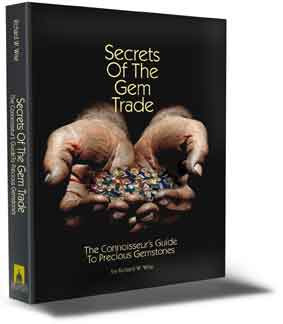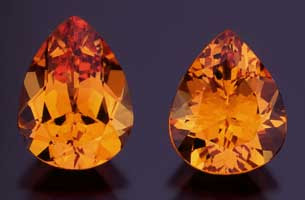
Collector’s Corner; How and What to Buy
© 2007
Everybody wants a steal, ‘er, deal:
I get a lot of emails from my readers with various questions. Friday I got a call from Diane, she read the book and wanted to know what stones a budding collector should be looking at. Now, when most people ask me that question what they really mean to ask is “what is available and cheap.” Why not, everybody wants a deal. Thing is in gemstones there are two kinds of deals.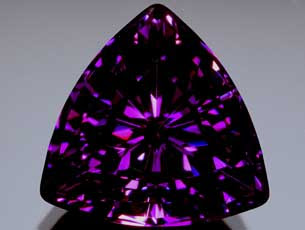
As a collector you should be looking for the fine and the rare. Fact is, in gemstones just about everything that is fine is, in fact, rare, the finer it is the rarer. I like to use the example of amethyst. Amethyst is quartz which, geologists tell us makes up almost 26% of the earth’s total bulk. So quartz isn’t particularly rare but, a beautiful transparent deep purple quartz that exhibits red scintillation in incandescent light is extremely rare. (Image above: #6999: 15.06 carat custom cut Deep Siberian Amethyst)
You can buy amethyst for between $1.00-100.00 per carat, quite a price spread but you will probably pay $50-100 per carat for a #1 color “deep Siberian” amethyst described above depending upon size, clarity, crystal and cut. You can buy #2 color, a beautiful deep purple amethyst that does not exhibit the requisite red flash for maybe $20-$35 per carat. Given the fact that #1 color is hundreds of times rarer and perhaps three times the price, you figure it out.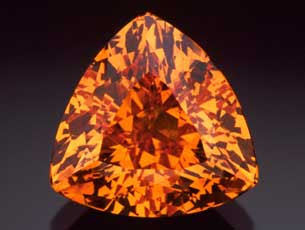
What’s hot, what’s not:
In Secrets Of The Gem Trade I write about something that might be called the Gemstone Market Price Cycle or (GMPC) (love those acronyms) The cycle works like this: When a new gem or a new source of an existing gemstone is found, the new material floods into the market increasing availability and decreasing price. Gems, other than diamonds, normally occur in fairly small pockets so the flood doesn’t last long. What does happen is the increased availability stimulates interest which translates into market demand. As demand increases the material begins to run out and as supply decreases, prices increase. By the time the dust clears the market price is higher than before the new material was found. (Image above: #6064: 6.93 carat Nigerian Spessartite Garnet)
Recently we have seen this happen with several gemstones. Consider spessartite garnet, the 4th most brilliant gemstone. A decade ago, most jewelers had never seen a spessartite never mind the hot tangerine orange gems available in the market today. Most fine spessartite came from one source; The Little Three Mine in Ramona California. This material was extremely rare in the marketplace and sold for fairly high prices. One knowledgeable dealer told me that the total production from Little Three was probably on the order of 10,000 carats. There was simply not enough spessartite to make a market which gives rise to the paradox that if its so rare that no one knows about it, there is no demand. (Image right:#8084: 9.51 carat Nigerian Spessartite Garnet)
simply not enough spessartite to make a market which gives rise to the paradox that if its so rare that no one knows about it, there is no demand. (Image right:#8084: 9.51 carat Nigerian Spessartite Garnet)
Enter the Nigerian find: All of a sudden there are Nigerian dealers all over Tucson with plastic bags full of juicy fruit orange rough. There is high quality spessartite everywhere and was it cheap. I remember selling 5+ carat extra-fine pure tangerine orange gems to collectors for $275-300 per carat. In the six years or so since the Nigerian strike the GMPC has played out; demand has increased, supply has decreased and prices have doubled. Prices now are higher then they were before the strike when the stone was a good deal rarer.
Of course this all took place BGT, Before 24 hour Gemstone Television really took hold back in the good old days when the free market was still alive and well. No one successfully had cornered any gem deposit and there was little if any hype to distort natural market forces. The effect of the shopping channels can be gauged by looking at Andesine, a form of sunstone that has become the darling of gemstone TV and is being sold by the shovel full to the unsuspecting at ridiculous prices.
Strategic Collecting:
So what’s a collector to do? Fact is the GMPC is still valid so long as y’all keep a jaundiced eye on gem TV. Two stones, spessartite and Peridot, particularly the material from Pakistan that began to trickle into the market in 1995 are still on the downside of the cycle, and, in my opinion, available in fine quality at reasonable prices. As for Spessartite, buy the high grade light-medium tone (30-40%) pure vivid orange to cinnamon orange. Remember once you go beyond medium tone, orange becomes brown and that is to be avoided.
Pakistan Peridot:
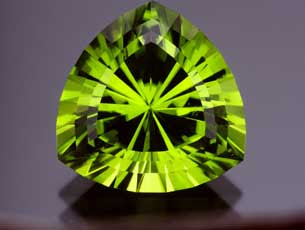
At its best, material from this source sports a medium grassy green primary hue. The best will read as as a strong medium toned green with just a touch of yellow and beware the gray mask. Pakistan Peridot will stand toe to toe with the best Burmese and is far superior in both size and color to the stones from the traditional Arizona source. Stones are eye-flawless and readily available in 5-10 carat and even larger sizes. (Image above: #7033: 8.09 carat Custom cut Pakistan peridot)
The rough material is getting scarcer and there is upward pressure on prices which are beginning to be felt in cut gemstone market. Peridot also has built in demand, it is also the traditional August birthstone. Every summer I have August babies come into my gallery, see cut stones from this source and fall in love.
My recomme
ndation: buy Spessartite and Peridot and buy only the best. And, just three words of caution to those of you who think that you that you can steal a fine gemstone on Thai websites, Fleabay or Gem TV, get over it! I recall one client, I think he was a Dentist, after I told him a story of one of my trips to Burma asked me, “but do they know what they have?” The Burmese have been digging ruby since the Bronze Age. Gems are one of the world’s oldest articles of trade. Fine gems made their way from Afghanistan to to ancient Sumer as early as 2000 B.C. With all that history, do you really believe these folks haven’t figured it out? Take my advice: If it sounds like too good to be true, it is too good to be true!
Book Review
Extra-Lapis #10: Opal, The Phenomenal Gemstone
by Richard W. Wise
© 2007
It just arrived, my latest Extra-Lapis, this one #10 entitled; Opal, The Phenomenal Gemstone. For those of you who don’t know, Lithographie, LLC of East Hampton, Connecticut www.lithographie.org. publishes an English version of the famous German gem/mineral magazine Extra-Lapis.  In the past few years monographs in this series have focused on gold, tourmaline and emerald along with numbers dedicated to important gem/mineral locations such as Madagascar and Pakistan and occasional forays in to mineral kingdom with issues on fluorite and calcite.
In the past few years monographs in this series have focused on gold, tourmaline and emerald along with numbers dedicated to important gem/mineral locations such as Madagascar and Pakistan and occasional forays in to mineral kingdom with issues on fluorite and calcite.
Extra-Lapis #10 is the latest word on opal. It includes articles on all the current producing areas as well as historically important locations both major and minor. The latest theories on what causes those tiny little silica spheres that create play-of-color to do the thing they do and much more.
Great writers too: The great husband and wife writing team Si and Ann Fraser kick the issue off with an overview of opal’s history as a gemstone. Much of this information is old hat but well organized and presented and include the intriguing assertion that Mexican opal was certainly known and valued by the Mayans and Aztecs and that, despite Pliny’s famous description, opal may not have been known by the Romans at all. In other articles; Veteran dealer Andrew Cody provides an overview of sources in South Australia, Elizabeth Smith, author of Black Opal Fossils of Lightning Ridge contributed an excellent piece on current conditions and mining at “The Ridge” including a scrumptious photo essay on black opal nobbies.
Other articles provide beautifully illustrated history and updates on diverse sources such as Slovakia, White Cliffs, Queensland, Virgin Valley, Honduras and Ethiopia. There is a map of worldwide opal locations, an interesting but incomplete glossary of opal terms. What is missing is a good bibliography and a solid discussion of opal classification and quality grading.
This latest 112 page offering is, like all the others, beautifully made and wonderfully illustrated. The editors go to great expense: Each softbound issue is printed on heavy chrome coat, printing and image reproduction is of the highest possible quality.
Extra-Lapis #10 is highly recommended to anyone interested in gemstones and is a must have for opal enthusiasts. The price is for #10 is $30.00 for a single issue but if you will take my advice buy a four issue subscription for $90.00.
Interested in reading more about real life adventures and secrets of the gem trade?  Follow me on gem buying adventures in the exotic entrepots of Burma and East Africa. Visit the gem fields of Austrailia and Brazil. 120 photographs including some of the world’s most famous gems. Consider my book: Secrets Of The Gem Trade, The Connoisseur’s Guide To Precious Gemstones.
Follow me on gem buying adventures in the exotic entrepots of Burma and East Africa. Visit the gem fields of Austrailia and Brazil. 120 photographs including some of the world’s most famous gems. Consider my book: Secrets Of The Gem Trade, The Connoisseur’s Guide To Precious Gemstones.
“Wise is a renowned author… He’s
done a marvelous job of this first book, monumental work, a tour de force…My recommendation: Buy this book”.
Charles Lewton-Brain, Orchid
Only $39.95. You can read a couple of chapters online: www.secretsofthegemtrade.com.
Buy it on Amazon: www.amazon.com
 steadily losing ground against the Thai baht since its 2001 high, recently went into freefall. Historic data. Although the dollar along with the euro remains the international currency of choice, Bangkok is the capital of the colored gemstone trade and Thai dealers think in baht and the dollar has lost 19% against the Thai currency since the September 2006 show.
steadily losing ground against the Thai baht since its 2001 high, recently went into freefall. Historic data. Although the dollar along with the euro remains the international currency of choice, Bangkok is the capital of the colored gemstone trade and Thai dealers think in baht and the dollar has lost 19% against the Thai currency since the September 2006 show.  educate the eye, including the Rockefeller Sapphire and many more of the world’s most famous gems. Consider my book: Secrets Of The Gem Trade, The Connoisseur’s Guide To Precious Gemstones.
educate the eye, including the Rockefeller Sapphire and many more of the world’s most famous gems. Consider my book: Secrets Of The Gem Trade, The Connoisseur’s Guide To Precious Gemstones.

